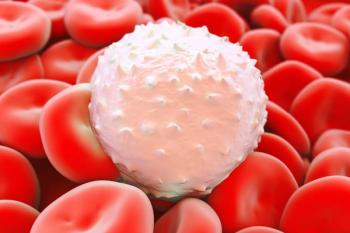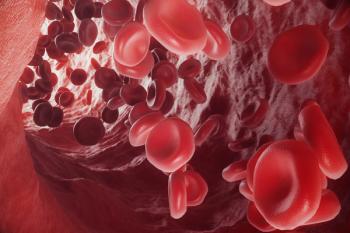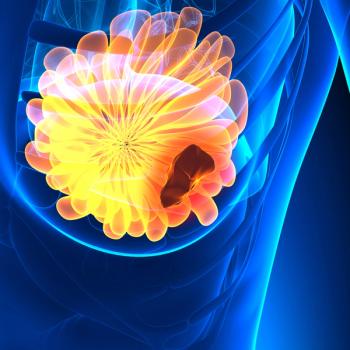
Primary Radiotherapy as De-Escalation Strategy Yields Efficacious Survival Outcomes in HPV-Associated Oropharyngeal Squamous Cell Carcinoma
Patients with human papillomavirus–associated oropharyngeal squamous cell carcinoma experienced efficacious survival benefits from treatment with primary radiotherapy.
Utilizing primary radiotherapy as a de-escalation strategy in patients with human papillomavirus–associated oropharyngeal squamous cell carcinoma resulted in efficacious oncologic outcomes, according to findings from the phase 2 ORATOR 2 trial (NCT03210103) presented at the
Patients who were treated with radiotherapy experienced a 36-month overall survival (OS) rate and 36-month progression-free survival (PFS) rate of 100% compared with 89.1% and 83.5%, respectively, among patients who received primary transoral surgery (TORS) with or without a reduction dose of adjuvant radiotherapy. Moreover, the radiotherapy arm achieved a mean MD Anderson Dysphagia Inventory (MDADI) score of 85.7 ± 15.6 at 1 year versus 84.7 ± 14.5 in the TORS arm (P = .85). Although 1 patient in each arm required a feeding tube, no patients required a feeding tube at 1 year.
Notably, the trial was stopped in November 2020 due to unacceptable grade 5 toxicities.
“Primary radiotherapy should be tested in phase 3 trials. Unfortunately, primary surgical approach was associated with an up-front risk of treatment-related mortality and suboptimal PFS,” according to David Palma, MD, MSc, PhD, FRCPC, a radiation oncologist at London Health Sciences Centre and a professor at Schulich School of Medicine & Dentistry, University of Western Ontario, in a presentation on the findings.
The purpose of the ORATOR 2 trial was to assess the long-term survival and safety of a primary reduced dose of radiotherapy with or without cisplatin weekly versus a primary surgical approach with or without adjuvant radiotherapy. Investigators enrolled patients with p16-positive oropharyngeal squamous cell carcinoma (n = 61) who were randomized to receive either 60 Gy of radiotherapy and weekly cisplatin at 40 mg/m2 for multiple positive lymph nodes or 1 node greater than 3 cm (n = 30), or TORS and neck dissection (n = 31). Those in the experimental arm could receive surgical treatment for persistent disease and the control group could receive 50 to 60 Gy of adjuvant radiotherapy based on risk factors. Investigators were notably looking to avoid a tri-modality therapy.
Additional inclusion criteria required patients to have T1 to T2, N0 to N2, M0 disease, as well as be a candidate for both surgery and radiation.
Those in the radiation arm were dosed with intensity-modulated radiation therapy based on disease subtype such as gross disease (60 Gy in 30 fractions), high-risk subclinical areas (54 Gy in 30 fractions), and low-risk nodal areas (48 Gy in 30 fractions). Those in the primary surgery cohort underwent TOS, which included mandatory ipsilateral external carotid artery ligation, with a strong recommendation for tracheostomy at the time of surgery. Fifty Gy of adjuvant radiotherapy in 25 fractions was administered to patients with intermediate risk features and 60 Gy was given to those with positive margins in 30 fractions.
The study’s primary end point was OS, with secondary end points including OS and PFS comparisons between arms, quality of life, and toxicity.
The overall patient population had a median age of 61.9 years (range, 57.2-67.9) and most were male (86%). Moreover, patients primarily had an ECOG performance status of 0 (73%) and fewer had a status of 1 (27%). Most patients had minor smoking history, according to Palma. The primary tumor sites were tonsil or tonsillar fossa (56%) or the base of tongue (42%). Investigators reported an even split of patients with T1 (52%) and T2 disease (48%) and 75% of patients had N1 disease.
Investigators reported 2 treatment-related deaths following TORS, including oropharyngeal bleed and cervical spine osteomyelitis. Additionally, grade 2 to 5 toxicities were similar across treatment arms and occurred in 67% of patients in the radiotherapy cohort and 71% of patients in the TORS cohort. The most notable differences were observed in grade 2/3 anorexia (P = .01) and dysgeusia (P = .03), which appeared to favor the surgical arm.
“Based on the current randomized data, I believe that the gold standard for de-escalation is what was exhibited in [the phase 2] HN002 [trial; NCT02254278]. HN002 included more advanced disease in the surgical trials and in the arm that received IMRT plus weekly cisplatin, outcomes were excellent, including the MDADI score of 85 and there were no grade 5 toxicities,” Palma concluded.
Reference
Palma D, Nichols A. A phase II randomized trial of treatment de-escalation for HPV associated oropharyngeal squamous cell carcinoma: radiotherapy vs. trans-oral surgery (ORATOR 2). Presented at: 2021 American Society for Radiation Oncology; October 24-27, 2021; Chicago IL. Accessed October 27, 2021. Abstract LBA-2
Newsletter
Stay up to date on recent advances in the multidisciplinary approach to cancer.

















































































